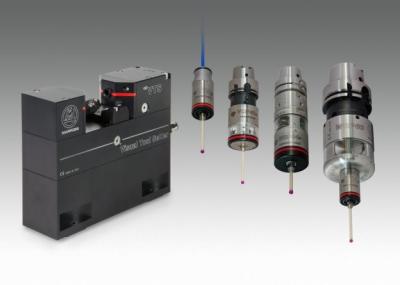
Marposs offers its high-accuracy Mida Diamond touch probes, which feature piezo-electric technology and are designed for 5-axis machining centers and milling machines. These probes, available in optical or radio transmission styles, provide enhanced measurement performance on 3D surfaces with repeatability within 0.25 µm and are well-suited to industries where precision requirements are pushed to the limits daily, such as die and mold, aerospace, aeronautics and biomedical.
Through automatic detection of machine axes position, these probes achieve part positioning, workpiece orientation and origin identification, as well as accurate part measurement. Relying upon a special filter, these probes can distinguish false-triggering events from actual touch events to provide better performance than other high precision probes, which might be sensitive to noise and vibrations, according to the company.
There are several types of applications are available. Operating with either a radio or optical receiver, the probes offer a wide operating field useful for large machines where line-of-sight between probe and receiver is not ensured. And, because the line of sight between the touch probe transmitter and receiver is not required, complex surfaces and deep cavity parts can be inspected. Measurements may be performed at depths as great as 1 m because of the modular structure and extensions of the probe.
The Mida Diamond line of machine tool touch probes and tool setters designed to control every step of the production process. Advantages of this probing line include reduced machining and checking times, increased production efficiency, reduced production rejects, and constant machining quality level during the entire production process.
Contact Details
Related Glossary Terms
- centers
centers
Cone-shaped pins that support a workpiece by one or two ends during machining. The centers fit into holes drilled in the workpiece ends. Centers that turn with the workpiece are called “live” centers; those that do not are called “dead” centers.
- gang cutting ( milling)
gang cutting ( milling)
Machining with several cutters mounted on a single arbor, generally for simultaneous cutting.
- milling
milling
Machining operation in which metal or other material is removed by applying power to a rotating cutter. In vertical milling, the cutting tool is mounted vertically on the spindle. In horizontal milling, the cutting tool is mounted horizontally, either directly on the spindle or on an arbor. Horizontal milling is further broken down into conventional milling, where the cutter rotates opposite the direction of feed, or “up” into the workpiece; and climb milling, where the cutter rotates in the direction of feed, or “down” into the workpiece. Milling operations include plane or surface milling, endmilling, facemilling, angle milling, form milling and profiling.

